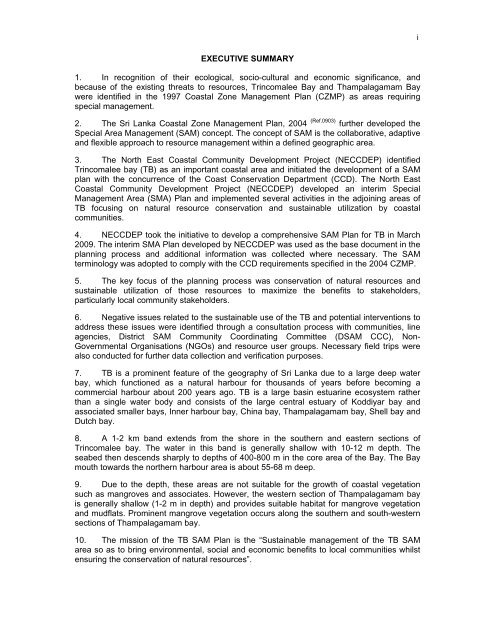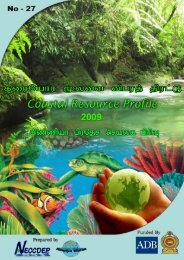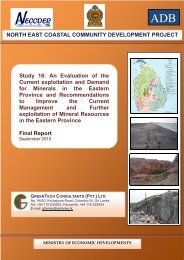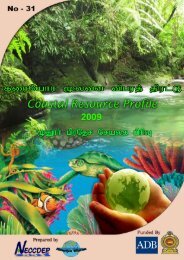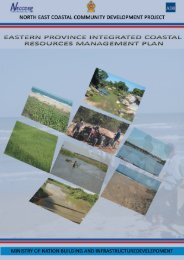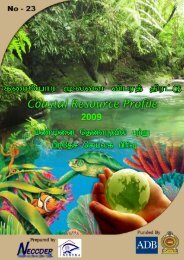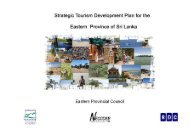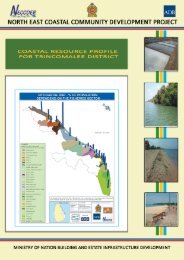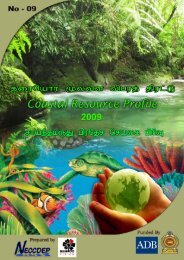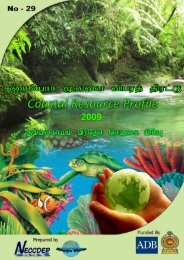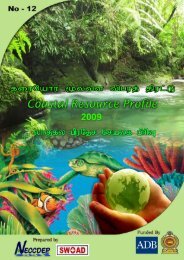Untitled - Neccdep.com
Untitled - Neccdep.com
Untitled - Neccdep.com
You also want an ePaper? Increase the reach of your titles
YUMPU automatically turns print PDFs into web optimized ePapers that Google loves.
i<br />
EXECUTIVE SUMMARY<br />
1. In recognition of their ecological, socio-cultural and economic significance, and<br />
because of the existing threats to resources, Trin<strong>com</strong>alee Bay and Thampalagamam Bay<br />
were identified in the 1997 Coastal Zone Management Plan (CZMP) as areas requiring<br />
special management.<br />
2. The Sri Lanka Coastal Zone Management Plan, 2004 (Ref.0903) further developed the<br />
Special Area Management (SAM) concept. The concept of SAM is the collaborative, adaptive<br />
and flexible approach to resource management within a defined geographic area.<br />
3. The North East Coastal Community Development Project (NECCDEP) identified<br />
Trin<strong>com</strong>alee bay (TB) as an important coastal area and initiated the development of a SAM<br />
plan with the concurrence of the Coast Conservation Department (CCD). The North East<br />
Coastal Community Development Project (NECCDEP) developed an interim Special<br />
Management Area (SMA) Plan and implemented several activities in the adjoining areas of<br />
TB focusing on natural resource conservation and sustainable utilization by coastal<br />
<strong>com</strong>munities.<br />
4. NECCDEP took the initiative to develop a <strong>com</strong>prehensive SAM Plan for TB in March<br />
2009. The interim SMA Plan developed by NECCDEP was used as the base document in the<br />
planning process and additional information was collected where necessary. The SAM<br />
terminology was adopted to <strong>com</strong>ply with the CCD requirements specified in the 2004 CZMP.<br />
5. The key focus of the planning process was conservation of natural resources and<br />
sustainable utilization of those resources to maximize the benefits to stakeholders,<br />
particularly local <strong>com</strong>munity stakeholders.<br />
6. Negative issues related to the sustainable use of the TB and potential interventions to<br />
address these issues were identified through a consultation process with <strong>com</strong>munities, line<br />
agencies, District SAM Community Coordinating Committee (DSAM CCC), Non-<br />
Governmental Organisations (NGOs) and resource user groups. Necessary field trips were<br />
also conducted for further data collection and verification purposes.<br />
7. TB is a prominent feature of the geography of Sri Lanka due to a large deep water<br />
bay, which functioned as a natural harbour for thousands of years before be<strong>com</strong>ing a<br />
<strong>com</strong>mercial harbour about 200 years ago. TB is a large basin estuarine ecosystem rather<br />
than a single water body and consists of the large central estuary of Koddiyar bay and<br />
associated smaller bays, Inner harbour bay, China bay, Thampalagamam bay, Shell bay and<br />
Dutch bay.<br />
8. A 1-2 km band extends from the shore in the southern and eastern sections of<br />
Trin<strong>com</strong>alee bay. The water in this band is generally shallow with 10-12 m depth. The<br />
seabed then descends sharply to depths of 400-800 m in the core area of the Bay. The Bay<br />
mouth towards the northern harbour area is about 55-68 m deep.<br />
9. Due to the depth, these areas are not suitable for the growth of coastal vegetation<br />
such as mangroves and associates. However, the western section of Thampalagamam bay<br />
is generally shallow (1-2 m in depth) and provides suitable habitat for mangrove vegetation<br />
and mudflats. Prominent mangrove vegetation occurs along the southern and south-western<br />
sections of Thampalagamam bay.<br />
10. The mission of the TB SAM Plan is the “Sustainable management of the TB SAM<br />
area so as to bring environmental, social and economic benefits to local <strong>com</strong>munities whilst<br />
ensuring the conservation of natural resources”.


